
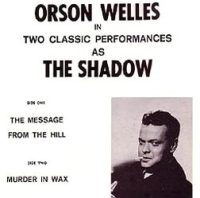 Who knows what evil lurks in the hearts of men?
Who knows what evil lurks in the hearts of men?
The Shadow knows!
The Shadow (1937-1954) aired “Message from the Hills” on May 22, 1938. Though only about 300 episodes are known to still exist out of over 800 (depending on how one counts), the number is subject to change as new episodes are unearthed from time to time. This is only the third episode we have featured since November of 2020 out of some three dozen overall, and I felt it was time for another, for The Shadow has proven quite popular with Golden Age radio fans, and especially fans of the Shadow in both radio and magazine formats.
The following is an abridged account of the character’s radio and magazine history for those coming to The Shadow for the first time. Long-time listeners may have forgotten some of the details, so if you are among them, refresh your memories or take a moment to grab your favorite beverage of choice before listening to this episode.
The history of the Shadow character is long and storied. A bare bones synopsis begins on July 3, 1930 when the narrator of magazine publisher Street & Smith’s radio version of its pulp magazine, Detective Story Magazine, was given the name of The Shadow. This mysterious voice who merely introduced and narrated the radio show, but was not a character in any of the episodes, became so popular after it was taken over by Frank Readick, Jr. and his spooky, phantom laugh that on April 1, 1931 The Shadow magazine was born. It ran for 325 issues, 282 of them written by Walter B. Gibson (1897-1985) under the house name of Maxwell Grant.
 The Shadow debuted on radio on September 26, 1937 and delighted fans for more than seventeen years, closing shop on December 26, 1954. The radio show began its long run on the Mutual Broadcasting Network on Sunday evenings and was sponsored by Blue Coal. From its inception until just past its first year (Sept., 1937-Sept., 1938) the voice of the young 22-year-old Orson Welles (1915-1985) would be heard as that of the Shadow, and Agnes Moorehead (1900-1974, photo at left) would play the role of “the lovely Margot Lane,” his “faithful companion” and aide. Following Welles’s departure (“Professor X” was his final episode) Bill Johnstone (1908-1996) became the Shadow for the September 25th, 1938 episode, at the beginning of Season Two. He was then succeeded by Bret Morrison (1912-1978), who, in two stints (1943-44 & 1945-54), was radio’s the Shadow for ten of its seventeen years (though others besides these three mainstays would ascend to the role). Moorehead would also exit the show
The Shadow debuted on radio on September 26, 1937 and delighted fans for more than seventeen years, closing shop on December 26, 1954. The radio show began its long run on the Mutual Broadcasting Network on Sunday evenings and was sponsored by Blue Coal. From its inception until just past its first year (Sept., 1937-Sept., 1938) the voice of the young 22-year-old Orson Welles (1915-1985) would be heard as that of the Shadow, and Agnes Moorehead (1900-1974, photo at left) would play the role of “the lovely Margot Lane,” his “faithful companion” and aide. Following Welles’s departure (“Professor X” was his final episode) Bill Johnstone (1908-1996) became the Shadow for the September 25th, 1938 episode, at the beginning of Season Two. He was then succeeded by Bret Morrison (1912-1978), who, in two stints (1943-44 & 1945-54), was radio’s the Shadow for ten of its seventeen years (though others besides these three mainstays would ascend to the role). Moorehead would also exit the show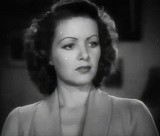 (in 1940) to follow Welles after he formed his Mercury Theater on the Air, as well as appear in several of the young genius’s classic films. That said, Moorehead would take a break (March to September of 1938) during the second season, at which time the more than capable Margot Stevenson (1912-2011, photo at right) would assume the role of Margot Lane.
(in 1940) to follow Welles after he formed his Mercury Theater on the Air, as well as appear in several of the young genius’s classic films. That said, Moorehead would take a break (March to September of 1938) during the second season, at which time the more than capable Margot Stevenson (1912-2011, photo at right) would assume the role of Margot Lane.
To arrest possible confusion arising from seeming inconsistencies between the print and radio versions of The Shadow it is important to note the following differences (though there are others):
The original print version of the Shadow portrayed him without any powers at all; he was a shadowy figure of the darkness, a cunning sleuth dedicated to overthrowing evil wherever he found it. It wasn’t until the radio version came along that he was imbued “with the power to cloud men’s minds” from a secret he learned in the Orient.
In The Shadow novels, Miss Lane’s first name was spelled Margo; for radio it was Margot.
In The Shadow novels, Margo Lane was not aware of the Shadow’s secret identity; for the radio scripts she was the only one who did know his secret identity.
In the magazine, the Shadow’s primary alter-ego was (eventually) revealed as that of Kent Allard; his radio alter-ego was Lamont Cranston.
This episode finds the Shadow and Margot in the jungles of the Orient, where they attempt to derail thoroughly evil diamond thieves whose eventual aim is to murder the local natives who work in the mine from which the fortune in diamonds is being harvested, the idea being to leave no witnesses behind. Along the way, we are introduced to the mysterious Tanga, and what Margot and the Shadow believe regarding the existence of telepathy. The story is full of bad actors and violent death for those who deserve it, so get set for quite the exciting adventure as the Shadow sends the bad guys a strong “Message from the Hills.”
The weed of crime bears bitter fruit. Crime does not pay. –The Shadow
Play Time: 29:30
{This episode of The Shadow aired on a Sunday evening, hardly a week before the end of the school year. This meant that it wouldn’t be long before the neighborhood gang would be out of the confines of their school and heading at a breakneck pace for the hills, in this case the local newsstand. Ready to free their imaginations, and granted the freedom of the upcoming summer vacation to aid in this worthwhile endeavor, the following SF pulps were quickly snatched by their new owners. Astounding SF (1930–present, now Analog) was a sure buy and had been for years, and this issue began the 3 part serial of the now classic Jack Williamson novel The Legion of Time. Astounding held to its monthly schedule in 1938. Thrilling Wonder Stories (1936-55) was all about the unfettered imagination, where colorful stories played fast and loose with the science but hit right on target with page-turning action in exotic locales around the galaxy. Fans loved TWS for its lively adventure tales, and here again we see a story by the ever-popular Jack Williamson being teased on the cover. TWS was a bi-monthly in 1938. Weird Tales (1923-54) was the creme de la creme of horror pulps for the discerning fan of the supernatural horror story, and is where the most favored and talented tale-spinners came to ply their trade. Known as the “unique magazine,” WT would more often than not end up being read in youngsters bedrooms with as many lights on as possible, for some of the stories would show them unimaginable horrors their young minds never knew existed, and WT accomplished this feat for over 30 years. And for a third time we see a Jack Williamson story on the cover, and to go along with his cover story in the April TWS we have a second tale by the incomparable Henry Kuttner sharing the cover with Jack Williamson. It would seem that both Williamson and Kuttner were having a fruitful summer with stories no doubt written over the winter now appearing in the spring months of 1938. WT was a monthly in 1938.}
[Left: Astounding SF, 5/38 – Center: Thrilling Wonder, 4/38 – Right: Weird Tales, 5/38]
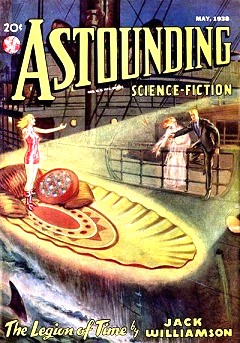
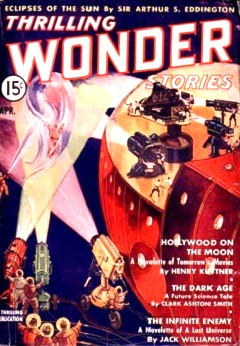
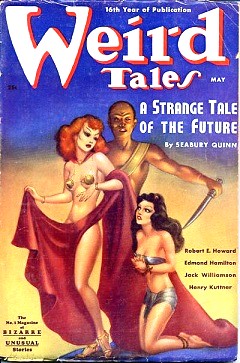
To view the entire list of weekly Old Time Radio episodes at Tangent Online, click here.